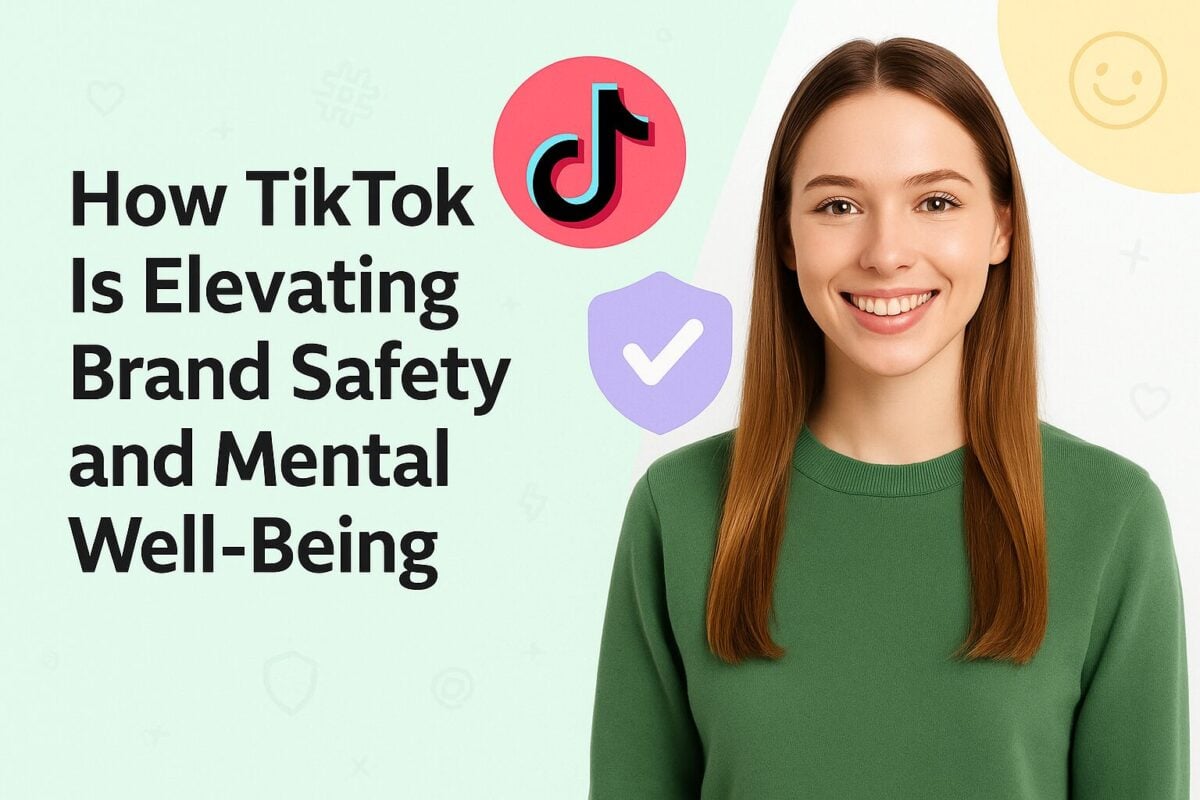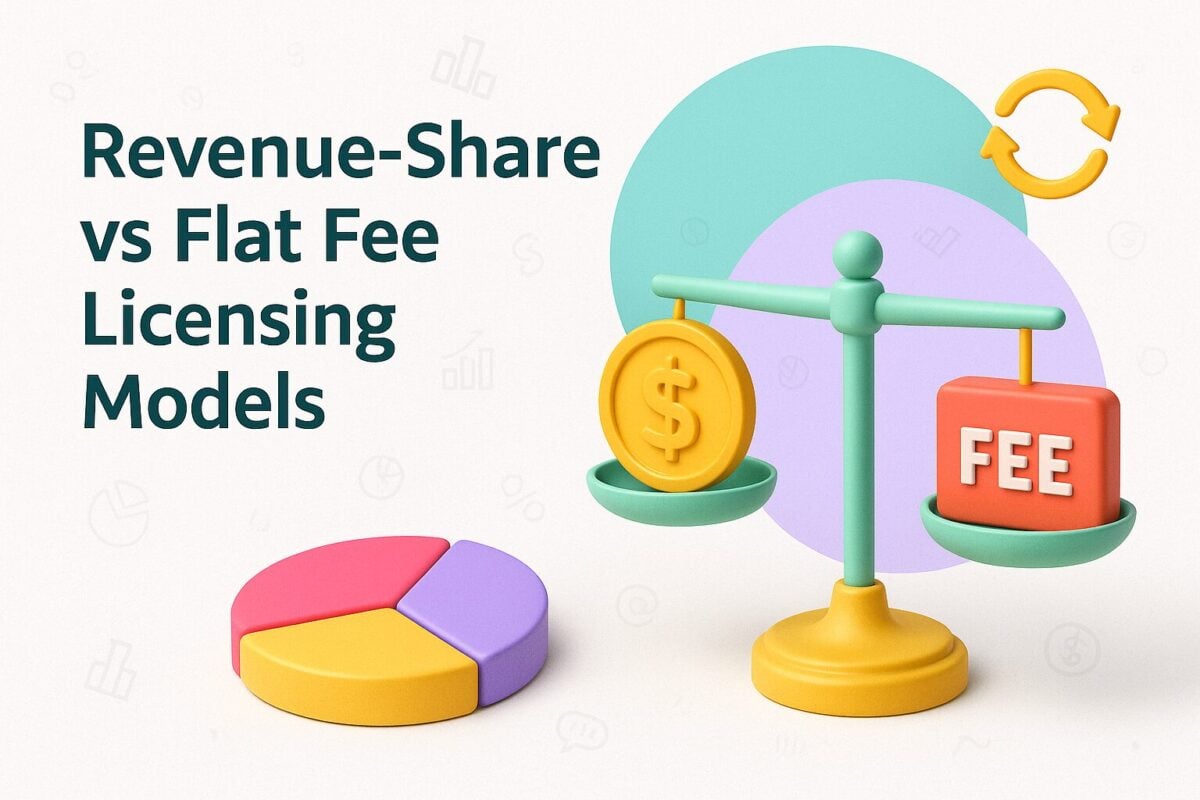Saying that most people spend a good part of their days on social media would not be an exaggeration. Not in today's world.
Social media has become an integral part of people's lives and daily routines. Some are addicted to it so much that the first thing they do after waking up is to check their social media feeds.
Given the importance of social media in consumers' lives, marketers and businesses flock to social platforms in the hope of connecting with their target customers. However, there is a content overload on social media, and the competition is very high. It can be challenging for you to stand out unless you have a clear social media marketing strategy.
Staying updated on the latest social media trends can help fuel your strategy and make you stand out in the crowd. For effective implementation of your social media marketing strategy, consider incorporating Social Media Scheduling Tools. In the meantime, here are 12 of the most important social media trends that you need to be aware of for 2024.
LATEST SOCIAL MEDIA BENCHMARK REPORT
Top Social Media Trends to Watch in 2024
1. The Rise of Short-Form Video Content in 2024
Shorter attention spans equal the need to quickly consume content and switch to the next. This has brought on a rise in short-form video, fueled by the introduction of platforms like TikTok. Instagram and YouTube have also adapted to these changing video consumption habits to introduce features such as Reels and Shorts, respectively.
As a platform that’s dedicated to short-form video, TikTok’s growth gives testimony to the immense popularity of this content format. Our Social Media Marketing Benchmark Report 2024 shows that the platform’s usage has reached 1.218 billion.
Consumers are also showing an increased preference for shorter videos, which explains the 2.5x higher engagement compared to long-form videos. Sprout Social even found that short-form videos are the most engaging type of in-feed social content.

This makes sense since shorter videos are easier to complete. In fact, videos shorter than 90 seconds keep 50% of viewers watching. The short, digestible format of these videos also means that 96% of consumers prefer them for quickly learning about a product or service.
HubSpot also reports that short-form videos are the most preferred method of discovering products, with 37% of consumers choosing this option. This is why even B2B brands have started to focus their video production efforts on short, TikTok-style videos to share behind-the-scenes footage, practical tips, and informational guides.
For instance, ShipBob regularly creates YouTube Shorts providing viewers with a closer look into their fulfillment process. Some of their fulfillment center tour videos have garnered hundreds of thousands of views.
Zendesk has also built a massive TikTok following by keeping their audience entertained through relatable humor, interesting interviews, and informative insights. The company’s TikTok page now has over 53k followers with most of their videos receiving over 100k views.
@zendeskPlease hold while I cry ?♬ sad hamster meme sound - CrazyToastCat
2. The Role of Artificial Intelligence in Shaping Social Media Trends
Improvements in artificial intelligence have driven increased adoption of the technology, which, in turn, influences social media trends. In particular, AI has significantly changed how marketers execute their social media strategies, with generative AI tools helping speed up content creation while AI-powered analytics enables data-driven strategies.
According to our AI Marketing Benchmark Report 2024, generative AI has resulted in over 42% of marketers changing their approach. For instance, the use of AI-generated avatars has become highly popular on platforms like TikTok. Almost 52% of marketers plan on using them in their TikTok campaigns.
These Symphony avatars allow brands and creators to craft custom avatars to accurately represent them in their TikTok videos. With the ability to speak multiple languages, these avatars allow brands and content creators to engage with a global audience with their likeness.
@tiktoknewsroomIntroducing TikTok Symphony: our new Creative AI suite that blends human imagination with AI-powered efficiency to help marketers scale content development, creativity, and productivity on TikTok.♬ original sound - TikTok Newsroom
TikTok’s AI suite has also helped marketers to improve various aspects of their content production. They’ve leveraged the suite to help with writing scripts, producing videos, and generating ideas.
On top of this, marketers have also adopted Symphony AI to improve their ad creation process. Ads created using this tool have been shown to improve brand favorability by 38% and purchase intent by 37%.
In spite of this, there’s also some level of concern over authenticity and trust regarding the use of AI in content creation. About 19% of marketers are concerned about consumer mistrust in AI-generated content. So there’s a need for marketers to maintain transparency when creating content with AI for their social media.
As a way to boost transparency and build trust, Meta has even come up with a new feature to label AI-generated images across Facebook, Instagram, and Threads. This allows brands and content creators to label content made using AI, enabling them to remain transparent and enhance trust.
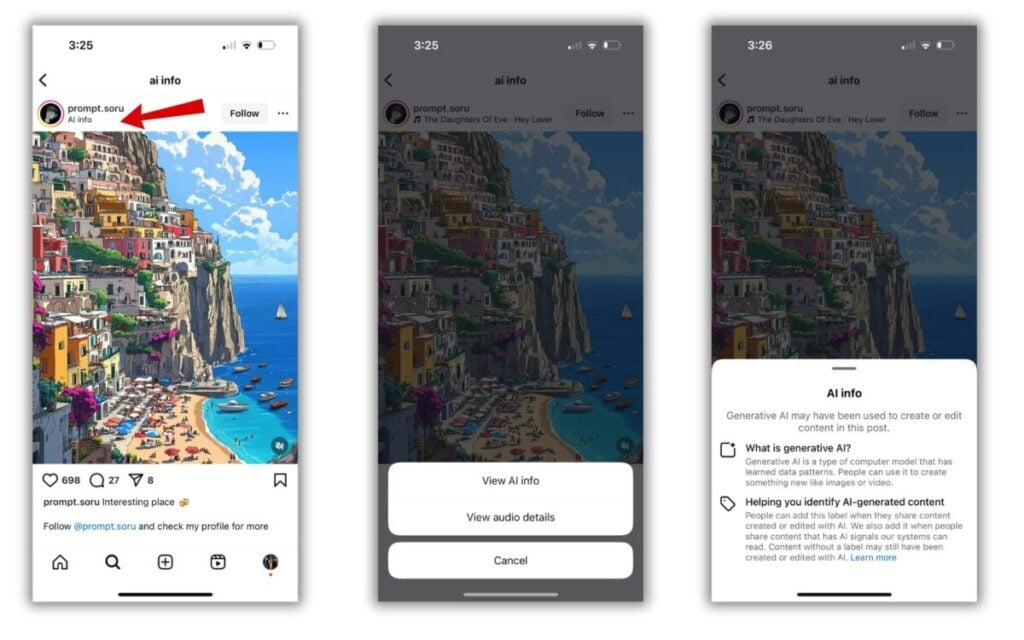
Source: instagram.com
AI’s powerful analytics capabilities have also enabled marketers to make data-driven decisions to optimize their social media performance. AI-powered social media analytics tools can extract valuable social media data at scale and provide you with actionable insights into your audience and competitors.
You can use these tools to get real-time recommendations on how to improve your strategy and ad campaigns, for instance. They can also conduct sentiment analysis on social media conversations and detect posts that require immediate attention. This saves you tons of time sorting through social media posts and quickly identifying time-sensitive posts to manage potential brand crises.
For instance, Domino’s used Emplifi to automatically sieve through X (formerly Twitter) conversations and find posts that need immediate attention. Since these time-sensitive posts constituted only 3% of the total conversations, the AI-powered analytics allowed them to save a significant amount of time weeding out the other 97%.
3. Augmented Reality: Transforming User Experiences on Social Media
In a constant bid to engage an online audience, brands have started to deliver immersive digital experiences through augmented and virtual reality. As such, the AR and VR market is seeing significant growth, with social media being a driving force. The latest virtual reality marketing reports reveal that VR and AR could potentially boost GDP by up to $1.5 trillion by 2030.
One of the most popular applications of AR in social media is interactive AR filters and effects. Meta launched its Spark Studio, which allows marketers to create Instagram AR filters. You can use the platform to create fully customized filters by choosing your filter type, adding objects, and adding effects.
These Instagram Stories AR filters allow your audience to interact virtually with your brand by placing objects in front of them, applying makeup, putting on costumes, and more. Some brands have even created gamified experiences with AR filters that let users play games using their facial expressions or hand gestures. The NBA came up with an AR filter that lets users test their knowledge by choosing the #1 Draft Pick by nodding their head to the left or right.
Meanwhile, brands like RMS Beauty came up with a filter that lets users try on various shades of their Legendary Serum lipstick. This type of filter can simplify the buying journey and increase purchase intent as customers don’t have to leave the Instagram app to find a shade that matches them.

Source: instagram.com
TikTok came up with its own version of the Spark Studio called the TikTok Effect House. This empowers marketers to come up with unique AR filters to promote their products and services through interactive content. In fact, our TikTok Marketing Report 2024 found that over 42% of marketers see significant opportunities in AR content.
Among the brands that have leveraged the TikTok Effect House to create AR filters, Drumstick created one where users could virtually place a Drumstick ice cream in front of them.
@drumstick we warned you…? #drumstick #drumsticksundaecone #drumstickfilter #arfilter ♬ tonight remix jersey - smi.le.mp3
4. Emphasizing Authenticity and Transparency in Social Media Content
The social media landscape is rife with competition, making it all the more important for brands to set themselves apart. Anyone can create polished promotional content that showcases their products in the best light. Now consumers want to engage with authentic and transparent brands with their audience on social media.
As a result of this, there’s a growing preference among consumers for genuine, behind-the-scenes content and relatable humor. A HubSpot survey even found that 68% of consumers prefer authentic and relatable content over polished, high-quality content.
Brands like Bali Body have been able to build a massive social media following through authentic Reels and TikTok videos showcasing how their products work. One TikTok video featuring uncut footage of someone applying their instant tan became viral, generating over 22 million views. The authentic nature of the 30-second clip perfectly showcased the effectiveness of the product without having to stage or polish it.
@bali_body Our viral instant tan evens skin tone and blurs blemishes in 30 seconds! ✨?? #instanttan #viralinstanttan #quicktan #selftan #tanninghacks ♬ original sound - balibody
The growing popularity of approaches such as personal branding also gives testament to the rising preference among consumers to build authentic human connections. Personal. Branding efforts enable brands to connect with the audience through a human representative, typically a leader.
As Alexis Quintal, CEO & Owner of Rosarium PR & Marketing Collective notes,
“In 2024, one of the most significant social media trends that brands should be acutely aware of is the growing emphasis on personal branding. This trend underscores the shift from corporate-centric to human-centric interactions on social media platforms, where audiences are increasingly drawn to authentic, relatable, and personal content.”
Quintal observes that the trend of personal branding is driven by the desire for authenticity and transparency.
“Consumers today are more skeptical of traditional advertising and prefer engaging with real people who share genuine experiences and insights,”
he explains.
“This has led to a surge in personal branding where business leaders, influencers, and even employees are stepping into the spotlight to represent their brands. By sharing their personal stories, behind-the-scenes glimpses, and expert opinions, they create a more trustworthy and relatable brand image.”
frank body co-founder Jessica Hatzis has a strong personal brand on LinkedIn, where she has amassed over 28k followers. As a Chief Marketing Officer for the cruelty-free skincare brand, Jessica regularly shares content and insights related to marketing. This has enabled her to grow a huge following made up of people who look up to her for her marketing expertise.
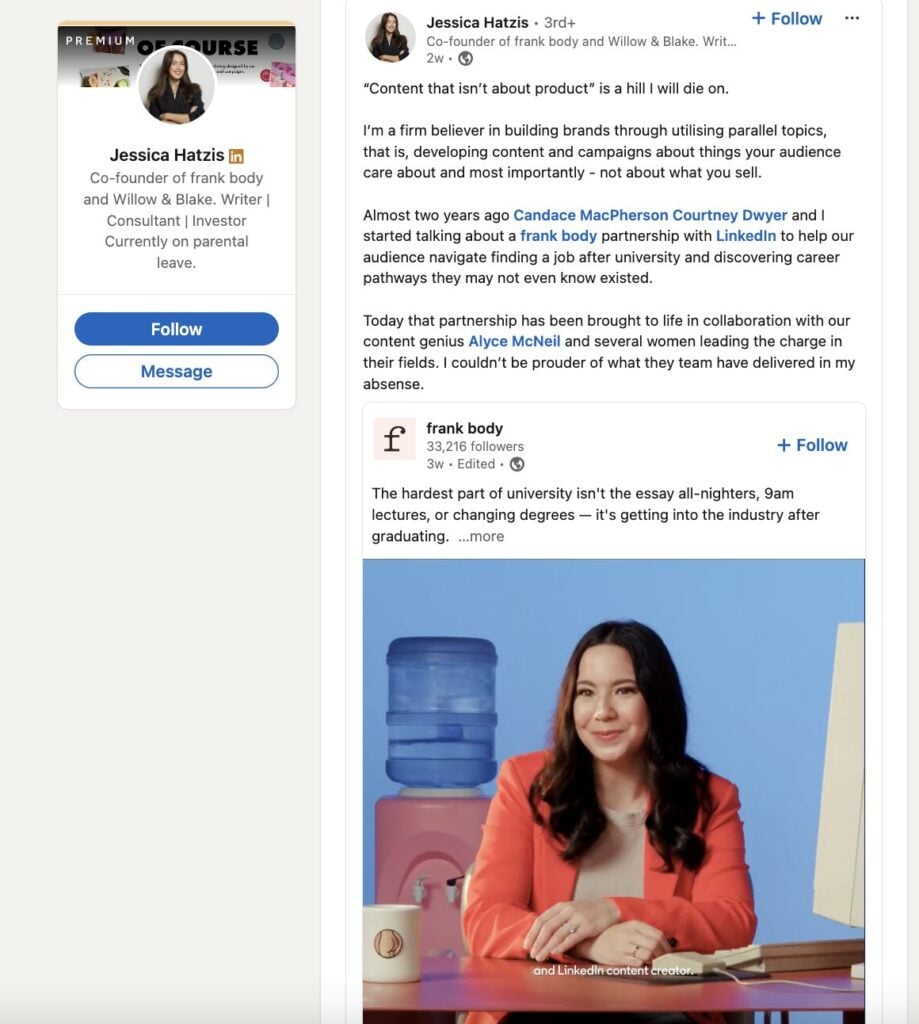
Source: linkedin.com
Alternatively, the success of perfume brand Kayali relies heavily on the personal brand of its founder, Mona Kattan. As a brand created by a social media influencer, Kayali’s social media promotions are often done as Collab posts with the founder, who has over 3 million followers. It also helps that most of the content resonates with the audience through relatable humor.
The following Reel, for instance, features a POV clip of Mona Kattan “sneaking into Sephora Mexico” and “stealing” bottles of Kayali perfumes. Combined with fun background music, this lighthearted approach to showcasing the desirability of the perfumes resonates with the audience, resulting in lots of positive feedback.
5. The Expansion of Social Commerce: Integrating Ecommerce with Social Media
With social media platforms constantly adapting to enhance the user experience while accommodating the needs of businesses, they’ve evolved into platforms for seamless eCommerce shopping. So they’re no longer just platforms for product and brand discovery. Now with social shopping features closely integrated into the platforms, users can easily go from product discovery to purchase without even leaving the app.
They’ll be able to tap on product tags in a post, view product details such as description and pricing, and complete the checkout process within the platform. This significantly simplifies and shortens the buying journey, removing barriers to purchase and reducing drop-offs. It’s no surprise that brands and consumers alike are embracing these features.
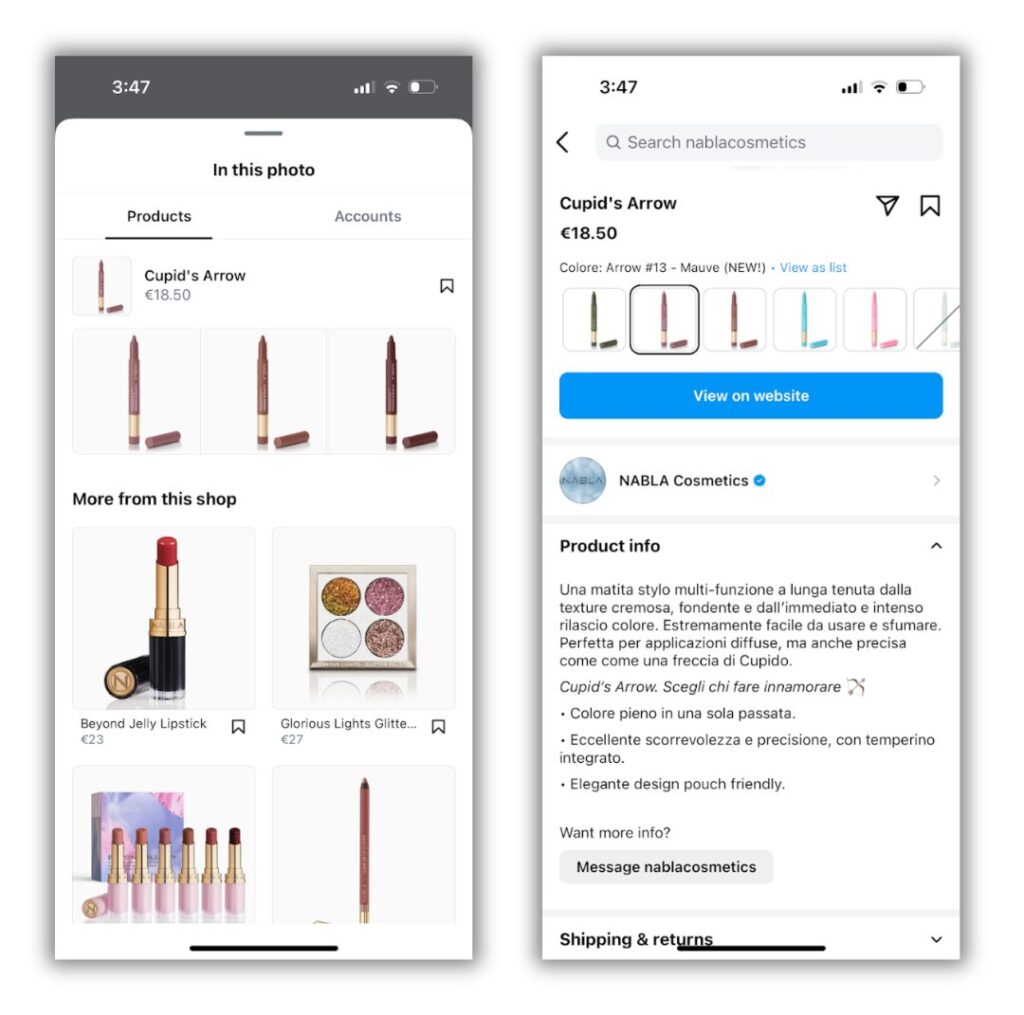
As they’re mostly mobile-focused, these social shopping capabilities are helping to fuel the growth of mobile commerce. eMarketer predicts that mobile commerce sales in the U.S. will hit $542.73 billion in 2024. It also found that a growing number of consumers were open to buying directly on social media.

After Instagram introduced the option to set up Instagram Shop in 2020, TikTok followed by launching TikTok shopping features in late 2023. This is expected to fuel significant growth in social commerce in 2024, especially with TikTok fueling product discovery and viral shopping trends. By 2023, global sales through social commerce had reached $1.298 billion, with the numbers expected to reach $1.698 billion in 2024.
Brands like Samsung have greatly benefited from TikTok’s social shopping features. One case study noted how the brand exceeded its sales target by 400% and saw a 4x increase in average order value with a winning TikTok Shop strategy.
Meanwhile, KimChi Chic Beauty developed a lucrative LIVE shopping strategy on TikTok to engage their community with real-time buying opportunities. They saw a 238% higher average product click-through rate, while gross media value (GMV) increased by more than 75x in 90 days. The brand also regularly creates shoppable videos that are entertaining and relatable, helping them to drive conversions after engaging the audience.
@kimchichic It's not crack, it's just pure Puff Puff Pass magic! ? This makeup staple will set your look throughout the day, blur imperfections, and lift your complexion! ? Sworn by MUAs and drag queens, Puff Puff Pass is a MUST-HAVE in your makeup bag. Tap to shop! ? #puffpuffpasspowder #settingpowder #whatisinthis ♬ original sound - KimChi Chic Beauty
Social media platforms have even introduced the option to incorporate shoppable content into advertising. This would allow brands to create shoppable ads where customers can quickly buy a product within the platform after encountering a paid promo for the same.
6. The Popularity of Ephemeral Content: Creating Urgency and FOMO
While Snapchat pioneered disappearing content, Instagram popularized its use in marketing. The latest Instagram stats reveal that 500 million people watch Instagram Stories every day. With content that only has a 24-hour lifespan, disappearing content compels users to view and engage “right now” instead of putting it off for later.
As a result of this, brands have been able to effectively create a sense of urgency and FOMO to engage their audience. From promoting limited-time offers and exclusive promotions to behind-the-scenes glimpses — brands are creatively leveraging this type of ephemeral content to drive in-the-moment engagement.
See how Target promotes a time-bound offer where customers can trade in their used car seats for 20% off. Having this offer up in their Stories makes it hard to miss, while the time-sensitive nature of the offer aligns perfectly with the content’s limited lifespan.
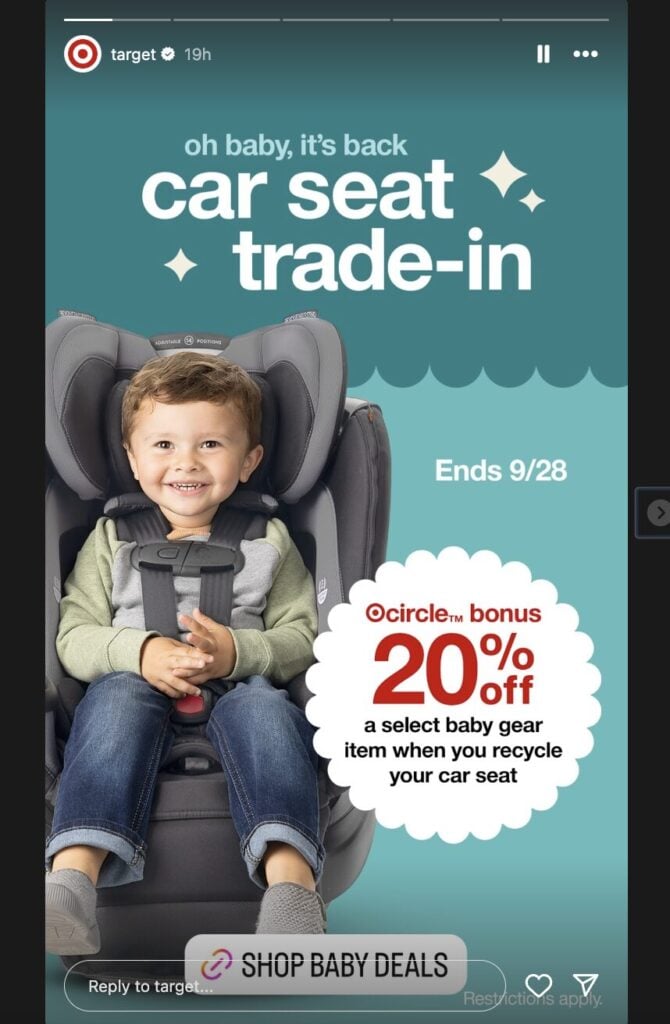
Source: instagram.com
Mae Jean Vintage also hosts Story sales where customers can get access to limited-time deals on select items only through their Stories. These time-sensitive discounts can create a sense of urgency and compel customers to make impulse buys.

Source: instagram.com
Meanwhile, Emilie of Ravenwood Restored shares timelapse videos and behind-the-scenes footage of her DIY projects. This gives her audience a glimpse into her process and builds a connection with her work.

Source: instagram.com
7. Building Strong Online Communities: The Key to Lasting Engagement
Speaking of connection, another major social media trend is a strong online community. When you’re in a constant battle with social media algorithms and competitor content, the best way for brands to build a lasting presence is by fostering a strong community of fans and customers. You need to build a community of followers who look forward to your content and actively participate in the conversation.
This will allow you to drive lasting engagement and build a solid brand-customer relationship. As a result, you can continue to market to an existing audience base and drive repeat purchases.
One of the best ways to build your brand community is by being responsive. Monitor your social media comments and respond to your customers to show them that you’re listening. Sprout Social even found that 51% of consumers believe brands are most memorable when they respond to customers on social media.
Beyond this, brands are also looking to alternative platforms like Reddit and Discord, which are known for their engaged communities. These are platforms that users go to to engage with like-minded people and participate in conversations about niche-specific interests. This makes them perfect for building communities that are relevant to your brand and industry.
For example, Blizzard has a dedicated subreddit where users can discover news about their video games and participate in relevant discussions. The subreddit already has 95k members, making it one of the top 2% of subreddits by size.
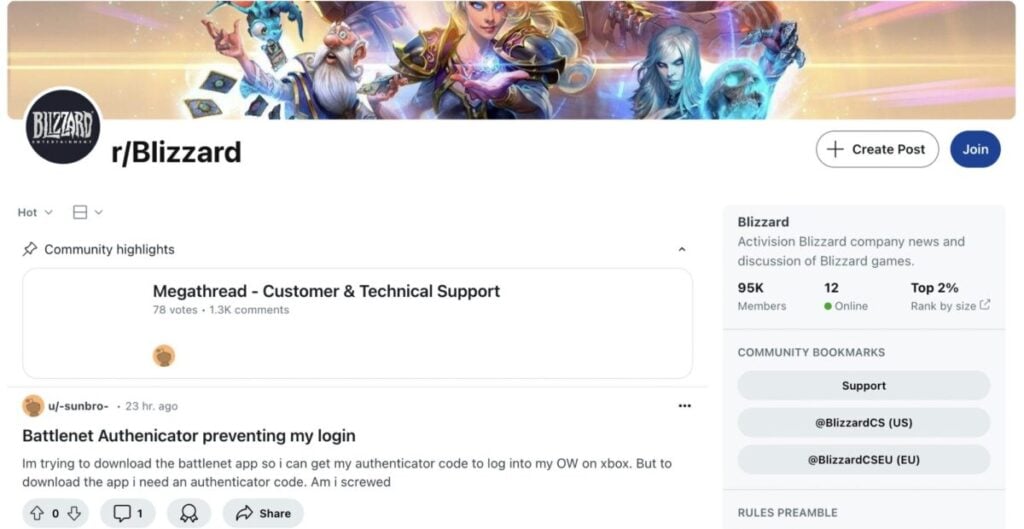
Source: reddit.com
Although platforms like Discord were once associated mostly with the gaming community, brands in other industries have started building communities on the platform. Initially fueled by the popularity of NFTs, these Discord servers allow brands to share exclusive content and nurture a thriving community.
The Gucci Vault, for instance, is a dedicated server created by GUCCI to nurture its brand community. The community is made up of over 46k members with varying interests — ranging from NFT creators to fashion enthusiasts. Members engage in discussions about the fashion house and its creative processes as well as share their insights about new collections and celebrity looks.

Source: discord.com
8. Developing Cross-Platform Strategies for Consistent Brand Messaging
When TikTok first came out in 2016, teens and young adults were among the largest adopters. For a few years after its launch, brands were still skeptical of using it for marketing. But the platform has since exploded in popularity, boasting over 1.5 billion monthly active users in less than a decade of its launch.
Then in 2023, Meta launched its own version of X (formerly Twitter) called Threads. In spite of some skepticism, the app has seen steady growth in adoption. Now the latest Threads stats report that it has gained almost 200 million monthly active users.
These numbers indicate that brands can’t afford to leave out new and emerging social media platforms in their marketing efforts. As more social networks enter the market, you never know which platform will become a viral sensation like TikTok. So there’s a need for brands to maintain their presence across those platforms to expand their reach.
More importantly, brands are looking to integrate their strategies to deliver a cohesive experience across all those platforms. This involves maintaining a consistent brand message across various social networks to strengthen your brand identity.
Of course, there will need to be some adjustments in content and formatting based on which platform you’re using. For instance, Threads is text-focused while TikTok is video-focused and Instagram is mostly focused on images and short videos. However, the essence of the messaging remains the same across all these platforms.
For instance, Duolingo is known for its winning TikTok strategy, which relies heavily on Gen Z humor and viral trends that align with its unhinged brand personality. There’s a reason the brand now has over 13 million followers on the platform.
@duolingo sad g(owl) hours #duoplushie #duolingo #languagelearning #emo ♬ Rio romeo - .???'?★
The same personality and brand messaging can be seen throughout other social media platforms where Duolingo maintains a presence. On Instagram, the company shares memes and Reels that are consistent with the same unhinged Gen Z humor seen on TikTok. The brand has amassed over 3 million followers on the platform.
On Threads, the brand continues to share unhinged jokes mostly using text. These posts see a ton of engagement, just like the brand’s content on other platforms. Duolingo now has over 654k followers on the platform, which is huge considering that Threads has only been around for about a year at the time of writing this post.
On LinkedIn, Duolingo polishes up the content a bit to align with the platform’s audience base. Since it’s a professional network, the content also focuses more on the life and people behind the company. However, you can still see some of the brand’s humor in their posts, like the one below.

Source: linkedin.com
9. The Surge in Influencer Marketing: Embracing Authenticity and Engagement
While influencer marketing itself is not a new social media trend, there’s a growing shift in how brands work with influencers. As consumers experience influencer fatigue from constantly being sold to by huge influencers and constantly seeing their aspirational lifestyle, there’s a thirst for authenticity. In fact, 44% of Gen Z consumers are infuriated from seeing the cash-rich lifestyles that influencers portray in spite of the cost-of-living crisis.
That’s not to say that influencer marketing no longer works. In fact, a Sprout Social survey found that 49% of consumers make regular purchases as a result of influencer posts. And 30% trusted influencers more than they did six months prior to the study, conducted in April 2024. So the onset of influencer fatigue mostly indicates that the usual methods of influencer partnerships now have a limited effect.
In fact, the Sprout survey also found that 64% of consumers would engage with an influencer’s genuine and unbiased review. This shows that consumers are still responsive to influencer promotions when the promotion is authentic.
As a result of this, we’re seeing a growing preference for smaller influencers with high engagement rates. When influencer marketing initially became popular, brands were rushing to work with influencers with a massive following. Now, however, our State of Influencer Marketing Benchmark Report found that more brands are choosing to work with nano- and micro-influencers.
In particular, nano-influencers are gaining popularity among brands. While 39% of brands preferred to work with them in 2023, the number increased to 44% in 2024. There’s been a slight drop in brands that choose to work with micro-influencers, from 30% in 2023 to 25.7% in 2024. However, these two influencer categories are still the most popular options among brands compared to large, macro- and mega-influencers.

This makes sense in a market that’s desperately craving authenticity as these smaller influencers tend to present a more genuine and relatable lifestyle. Moreover, they seem to generate a higher level of engagement than their counterparts with massive followers, which makes them particularly valuable at a time when social media engagement rates are at an all-time low.
On Instagram, for instance, nano-influencers boast an impressive engagement rate of 6.23%. Meanwhile, the Social Media Marketing Benchmark Report notes that the median engagement rate on Instagram stands at 0.47%. So you can see the massive difference that smaller influencers can make on brand visibility and engagement.
While smaller influencers may not be able to reach hundreds of thousands of people at a time, brands make up for this limited reach by working with multiple influencers. According to our State of Influencer Marketing report, 60% of brands work with at least 10 influencers. So it’s common to see influencer activations, such as product seeding campaigns, that involve multiple nano- and micro-influencers.
That said, there’s another challenge associated with finding influencers who will be willing to promote your brand in exchange for free products. Not to mention the challenge involved with finding creators with authentic influence when the market is flooded with fraudulent influencers.
So brands make use of influencer marketing platforms like Upfluence and Aspire to simplify the search process. Upfluence, for instance, can integrate with your Shopify store to help you discover influential content creators who are already buying from your brand. This makes room for authentic partnerships with influencers who are genuine fans. This strategy helped brands like BeautyLab generate $1.4 million in sales and see 19x ROI in three months.
Additionally, the growing use of AI-powered tools is helping brands to optimize their influencer marketing efforts. According to our State of Influencer Marketing Report, 60% of marketers were planning to use AI or machine learning in their influencer marketing campaigns, with the main area of focus being influencer identification.
This makes sense, especially with AI having the capability to quickly analyze influencer profiles for authenticity, which will speed up the fraud detection process. For instance, AI-powered influencer marketing platforms like HypeAuditor can analyze influencer profiles and assess their audience quality and brand affinity. So you can efficiently identify potential influencers who are a close match for your brand and can reach real people.

10. Boosting Engagement with Interactive Content
With a gradual decline in organic visibility and a constantly evolving algorithm, most social media platforms require high levels of engagement to expand your reach. This makes it vital for brands to look for opportunities to drive engagement through their social media posts.
Fortunately, platforms are also constantly introducing new features to drive user engagement, making it easier for brands to leverage interactive content in their strategies. For instance, Instagram Stories offers multiple interactive stickers such as polls, quizzes, and sliding votes. Meanwhile, X (formerly Twitter) and LinkedIn offer poll features so you can get people to vote for your posts.
More recently, Instagram introduced the option to add polls to the caption of your feed posts. These types of Instagram polls make it easier to collect audience responses over a longer period of time.
Brands are leveraging these features to come up with interactive content and drive audience engagement. This could make a huge difference in your social media performance as interactive content is known to drive 2x more engagement and up to 5x more views compared to static content.
Brands like Mapcha Studio use this feature to gauge customer opinion about bringing back a best-selling item.
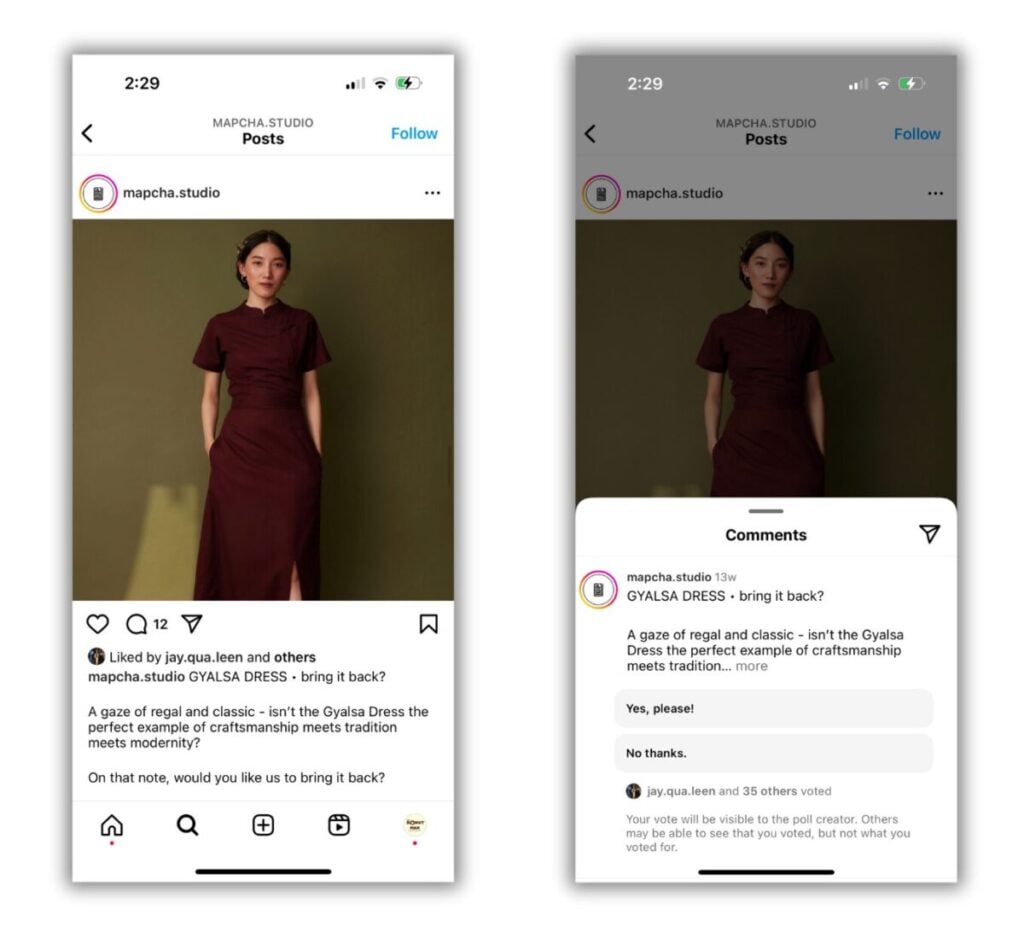
Source: instagram.com
Alternatively, Card Price Check uses it to simply drive engagement and start a conversation about product launch news.
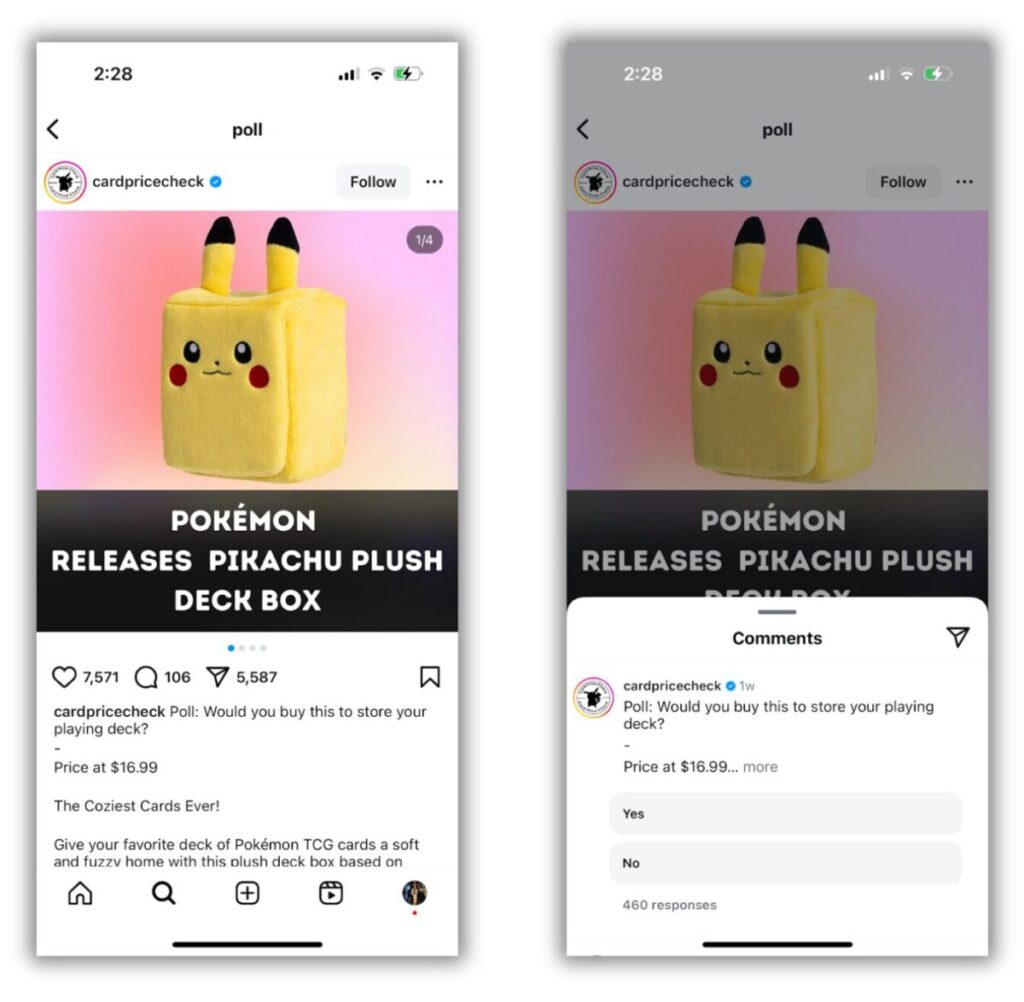
Source: instagram.com
Some brands don’t even make use of these features to create interactive content. They find creative ways to encourage their audience to engage and boost interactions. For instance, Lay’s created the following post on X asking people to fill in the blanks. It received hundreds of contributions, resulting in over 64k views.
Finish the sentence and we might send you Lay's. Only Lay's can ________.
— LAY'S (@LAYS) September 7, 2024
11. Optimizing Social Media Content with SEO Strategies
The decline in organic visibility also compels brands to adopt various strategies to improve their social media reach. As a result, they’ve come to incorporate SEO best practices to optimize their posts and profiles and improve discoverability.
This involves the strategic use of keywords in your bio, hashtags, and captions. So when a user searches for those keywords, there’s a higher chance that they’ll come across your profile or post. That way, you can effectively reach people who are actively searching for products or content related to your brand.
So if someone searches for “cruelty-free skincare” on Facebook, they’ll discover Pages, Groups, and posts that incorporate the keyword. This allows them to find information and content related to their topics of interest.
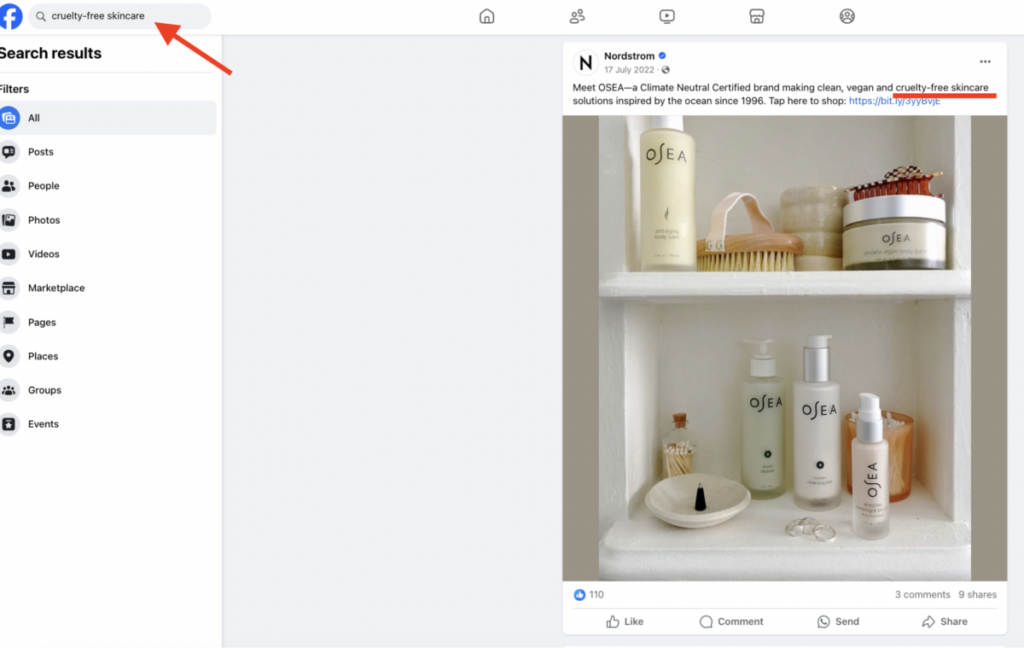
Source: facebook.com
The trend of incorporating SEO strategies into social media has become all the more important with younger users relying on various social networking platforms to conduct online searches. Forbes Advisor reports that 24% of survey respondents primarily use social media apps to search online and discover new brands daily. The number is especially higher among Gen Z respondents, with 46% turning to social media for their informational needs.
While many brands are keeping their followers entertained with short and creative captions, they’re also creating posts with more descriptive captions where they can make use of keywords strategically.
For instance, see the following post from Osea Malibu where you can find the use of keywords like “clinically tested skincare” and “clean beauty.” They also leverage the trending hashtag, #SkincareAwarenessMonth to further boost visibility among users interacting with said keyword.
12. Leveraging Social Media for Effective Customer Support
Finally, the trend of using social media beyond its main purpose extends over to brands leveraging it for customer support. This trend largely coincides with the growing expectation among consumers to use social media as a channel for connecting with brands and getting support.
A Sprout Social survey found that 76% of consumers value brands that prioritize customer support and respond quickly to their needs. However, simply providing support through social media isn’t enough. Consumers have a high expectation of how the support is provided, with 69% expecting to get a response on the same day. Moreover, 70% expect the responses to be personalized to them.
These growing expectations place an insurmountable challenge on brands to be extremely responsive while ensuring that the customer experience is tailored to each user. As a result of this, brands are turning to AI and automation tools for assistance in delivering the kind of customer support experience that consumers expect on social media. The same survey found that 47% of brands were planning to use AI and automation to help them handle customer inquiries at scale.
That said, there’s a certain level of hesitation about the use of AI in handling interactions on social media. One-third of respondents have concerns about balancing AI and human touch in their social media interactions. Moreover, 42% of consumers have some qualms about brands using AI in their social media interactions.
Considering this, brands are faced with the challenge of automating their support-related social media inquiries without completely stripping away the human element of these interactions. So it’s important to strategically use AI and automation tools for assisting your social media support team as opposed to relying on these tools to handle all your social media interactions.
Spotify has a dedicated Spotify Cares handle on X to handle all support-related queries. The brand uses this handle to come up with personalized responses instead of simply using copy-pasted answers. These responses sometimes include a “Send Us a Private Message” button so customers can easily tap to continue interacting with the business via DMs.
Hey! The cavalry's here. Could you DM us your account's email address, the URIs of the artists involved, and more info on what's happening? We'll take a look backstage. https://t.co/ldFdZRiNAt
— SpotifyCares (@SpotifyCares) September 17, 2024
Depending on the issue, Spotify also sometimes provides answers and solutions directly in the thread. See the following thread where the team apologizes and offers to pass the feedback to the Ads team. In the second attempt, the team also provides additional steps on how to solve the customer’s issue.
Hi again! To get the 30-minute ad-free music, be sure to keep the video ad in focus. Don't navigate to another app, browser, etc. Make sure that you're not accidentally clicking the "No, thanks" button as well, when prompted to watch the ad. Hope this helps.
— SpotifyCares (@SpotifyCares) September 17, 2024
Making the Most of These Social Media Trends
When it comes to social media, marketers are faced with the unique challenge of adapting to an ever-evolving landscape. New platforms, feature updates, viral content, and changing consumer behavior make way for new trends that shape marketing strategies. Make the most of these latest social media trends to adapt and get ahead of the competition.
Frequently Asked Questions
What are the biggest trends in social media right now?
Short-form video, nano-influencer marketing, authentic content, and AI tools are some of the biggest trends in social media right now.
How is AI influencing social media marketing strategies in 2024?
Improvements in generative AI are driving content creation efforts while AI analytics are helping marketers make informed data-driven decisions to boost their strategies.
Why is authentic and transparent content becoming more important?
Authentic and transparent content are becoming more important as brands need to stand apart from the competition and build genuine connections with their audience.
What role do influencers and creators play in social media trends for 2024?
Influencers and creators still play an important role in influencing social media trends for 2024, with the focus shifting on smaller influencers and creators who can help brands drive authentic connection with their target audience.
What strategies can help brands stay updated and relevant with social media trends?
Brands can stay updated and relevant with social media trends by using social listening tools to keep up with viral topics and trending conversations. Moreover, social media analytics platforms can help them gain insights into their competitors’ strategies to keep up with trends that they can adopt into their own approach.
Why is SEO becoming important for social media platforms?
SEO is becoming more important for social media platforms as consumers are increasingly leveraging them to conduct online searches.

